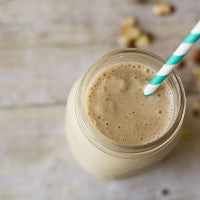We know we need protein, but do we know why we need it? Get to know this nutrient and everything it does for us!
What is protein? Do I really need it? How much? What does a monkey look like if he doesn't get enough protein? These questions are all answered in a fun video for all our Sunwarriors out there. What is Protein is a fairly short (4:49) whiteboard animation featuring protein and what sets Sunwarrior apart from the rest. Watch mesmerizing hand-drawn characters come to life before your eyes. We're excited to share it.
Protein is the most abundant molecule, apart from water, in our bodies. We always think of muscle when we talk about protein or about their components, amino acids, but these essential little building blocks are found in every cell and tissue throughout the body.
 Protein facilitates the digestion and absorption of nutrients. It acts as a cell's hands to grab and carry those nutrients into their interiors. And it removes waste and toxins. Protein combines with vitamins and minerals to do even more: move oxygen from the lungs and to cells that desperately need it to survive, act as antioxidants (cleaning up free radicals that do cellular damage and contribute to cancer and aging), and aid the immune system in recognizing and removing threats to our health and wellness. It even goes into hormones our bodies use to balance and regulate hundreds of systems and functions, from blood sugar to emotions.
Protein facilitates the digestion and absorption of nutrients. It acts as a cell's hands to grab and carry those nutrients into their interiors. And it removes waste and toxins. Protein combines with vitamins and minerals to do even more: move oxygen from the lungs and to cells that desperately need it to survive, act as antioxidants (cleaning up free radicals that do cellular damage and contribute to cancer and aging), and aid the immune system in recognizing and removing threats to our health and wellness. It even goes into hormones our bodies use to balance and regulate hundreds of systems and functions, from blood sugar to emotions.
This nutrient is able to be such an extremely versatile molecule thanks to what goes into it and how it's made. The body synthesizes proteins from amino acids, forming them into long chains. The chains can then twist and fold into unique shapes with practically endless possibilities and combinations in form and function. The bonds in these chains make protein very strong, flexible, and elastic, like a spring, perfect for both muscles and enzymes that need to move, shift, and react.
Proteins do have a weakness though. Their kryptonite? Heat. To be fair, it has two kryptonites: heat and extreme pH. These break the bonds that hold the twists and folds together, destroying any of the abilities that protein might have once held. Many of the enzymes we eat in whole foods help break down other proteins during digestion and also make many vitamins and minerals easier to absorb, but cooking can remove these benefits. Heat can also create cross bonding between proteins where denatured chains randomly link to other chains. These cross bound proteins are harder to digest and put to use, so many of the amino acids are lost, discarded as waste.
 There are other problems with the protein we eat. Some of these amino acids can be made by the body, but some must come from diet. Since the body doesn't store amino acids, we do need a daily supply, but too much can be harmful. Excessive protein bogs down digestion, can supply way more calories than we need, and does harm to the liver and kidneys. Too little is also a problem, making us weak and more susceptible to disease and illness.
There are other problems with the protein we eat. Some of these amino acids can be made by the body, but some must come from diet. Since the body doesn't store amino acids, we do need a daily supply, but too much can be harmful. Excessive protein bogs down digestion, can supply way more calories than we need, and does harm to the liver and kidneys. Too little is also a problem, making us weak and more susceptible to disease and illness.
Sunwarrior strives to provide a clean, healthy amount of quality protein with a balanced amino acid profile, not too much, not too little. This protein is also raw, undamaged by heat, and ready for maximum absorption. Sunwarrior can be easily added to vegan protein smoothies for the best plant-based amino acids followed by amazing performance and recovery, without the downsides of bloating, gas, gluten, denatured proteins, allergens, or phytoestrogens that can be found in whey, casein, and soy. Take a look at Warrior Blend, Sunwarrior Classic, and Classic Plus today and discover the difference for yourself.





